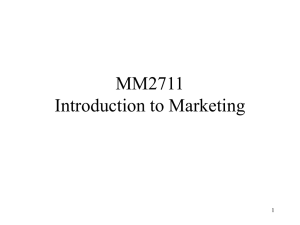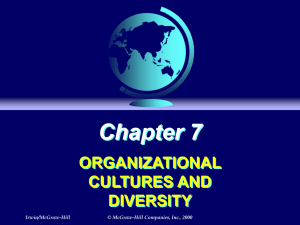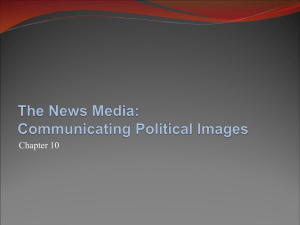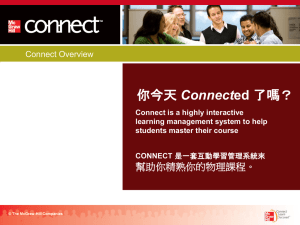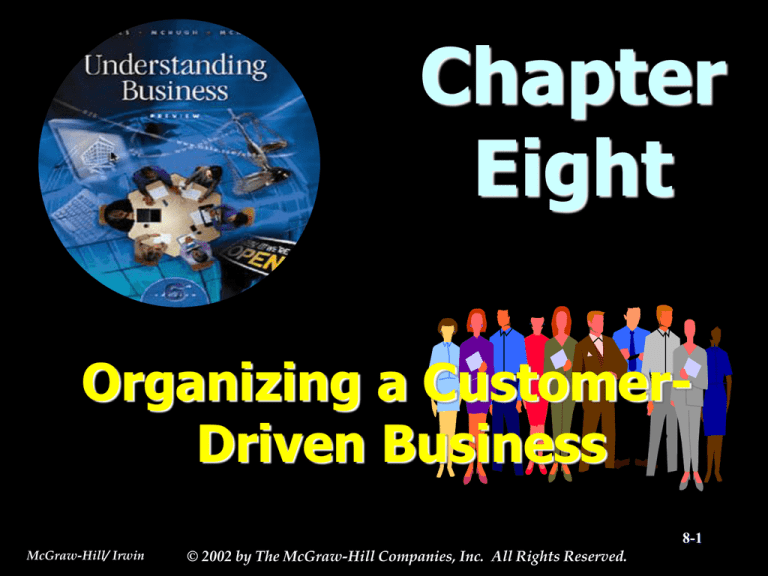
Chapter
Eight
Organizing a CustomerDriven Business
8-1
McGraw-Hill/ Irwin
© 2002 by The McGraw-Hill Companies, Inc. All Rights Reserved.
Management Pyramid
CEO,
Top
Comptroller,
Vice Pres.
Sales Mgrs
Plant Mgrs.
Mid-Level
Front Line/Supervisory
Supervisors
Foremen
8-2
McGraw-Hill/ Irwin
© 2002 by The McGraw-Hill Companies, Inc. All Rights Reserved.
Workers in Large* Companies
During the Last 5 Years
Have Undergone...
Declining Sales or
Profits
*500+ Employees
Downsizing or
Layoffs
Merger or
Acquisition
Reengineering or
Reorganization
0%
10%
20%
30%
40%
50%
60%
70%
Source: Gallup for Carlson Marketing Group
8-3
McGraw-Hill/ Irwin
© 2002 by The McGraw-Hill Companies, Inc. All Rights Reserved.
Purpose of an
Organizational Chart
Show the activities
of the organization
Highlight
subdivisions of the
organization
Identify different
types of work
performed
Provide information
about different
management levels
Show the lines of
authority in the
organization and
the flow of
organizational
communications
8-4
McGraw-Hill/ Irwin
© 2002 by The McGraw-Hill Companies, Inc. All Rights Reserved.
Organizational Design
Organization
CEO
D ivisio n V .P .
D e p a rtm e n t A
G ro u p 1
S u b o rd in a te I
D e p a rtm e n t B
G ro u p 2
S u b o rd in a te II
D ivisio n V .P .
Division
Department
Group
Individual
8-5
McGraw-Hill/ Irwin
© 2002 by The McGraw-Hill Companies, Inc. All Rights Reserved.
Fayol’s Principles
of Organization
Unity of
Command
Hierarchy of
Authority
Division of Labor
Subordination of
Individual
Interest
Authority
Degree of
Centralization
Communication
Channels
Order
Equity
Esprit de Corps
8-6
McGraw-Hill/ Irwin
© 2002 by The McGraw-Hill Companies, Inc. All Rights Reserved.
Weber’s
Organizational Principles
Job
Descriptions
Written Rules
Procedures, Regulations,
Policies
Staffing/Promotions based on
Qualifications
8-7
McGraw-Hill/ Irwin
© 2002 by The McGraw-Hill Companies, Inc. All Rights Reserved.
Fundamentals
of Bureaucracy
Chain of Command
Rules & Regulations
Set Up by Function
Communication = Minimal
B oss
V ice P resid en t
S u p ervisor
E m p loyee
8-8
McGraw-Hill/ Irwin
© 2002 by The McGraw-Hill Companies, Inc. All Rights Reserved.
Organizational Structures
Tall Organizations Flat Organizations
- Many Layers of
- Current Trend
Mgmt.
- Creation of
- Cost of
Teams
Mgmt.=High
8-9
McGraw-Hill/ Irwin
© 2002 by The McGraw-Hill Companies, Inc. All Rights Reserved.
Span of Control
Capabilities
of Subordinates
& Manager
Complexity of Job
Bo ss
S u b o rd in a te
S u b o rd in a te
S u b o rd in a te
Geographically
Close
Functional Similarity
Need for Coordination
Planning Demands
Functional Complexity
8-10
McGraw-Hill/ Irwin
© 2002 by The McGraw-Hill Companies, Inc. All Rights Reserved.
Departmentalization
C o lle g e
Advantages
Skill
Development
Economies of
Scale
Good
Coordination
P re sid e n t
Bu sin e ss E d u c a tio n
C o m m ., H u m a n itie s,
S o c ia l S c ie n c e s
D e ve lo p m e n ta l
S tu d ie s
M a th , S c ie n c e s,
H e a lth S c ie n c e s
T e c h n ic a l, In d u stria l
S e rvic e O c c u p a tio n s
8-11
McGraw-Hill/ Irwin
© 2002 by The McGraw-Hill Companies, Inc. All Rights Reserved.
Departmentalization
Disadvantages
Lack of
Communication
Employees Identify
with Department
Slow Response to
External Demands
Narrow Specialists
8-12
McGraw-Hill/ Irwin
© 2002 by The McGraw-Hill Companies, Inc. All Rights Reserved.
Departmentalization
Product
Function
Customer
Location
Process
8-13
McGraw-Hill/ Irwin
© 2002 by The McGraw-Hill Companies, Inc. All Rights Reserved.
Centralization
(No Delegation)
Advantages
Increased
Uniformity
Less
Duplication
Maximum
Control
Disadvantages
Lots of Policies
& Procedures
Many
Layers/Slower
8-14
McGraw-Hill/ Irwin
© 2002 by The McGraw-Hill Companies, Inc. All Rights Reserved.
Decentralization
(Delegate Authority)
Advantages
Informed
Decisions
Worker
Responsibility
Few
Layers/Faster
Disadvantages
Loss of
Control
Possible
Duplication
8-15
McGraw-Hill/ Irwin
© 2002 by The McGraw-Hill Companies, Inc. All Rights Reserved.
Line Organizations
Advantages
Clear Authority &
Responsibility
Easy to
Understand
One Supervisor
per Employee
Disadvantages
Inflexible
Few Specialists
for Advice
Long Line of
Communication
Difficult to Handle
Complex
Decisions
8-16
McGraw-Hill/ Irwin
© 2002 by The McGraw-Hill Companies, Inc. All Rights Reserved.
Layers of Authority
Top
ManagersDecision Makers
Middle ManagersDeveloped Rules &
Procedures
Workers and
Supervisors
8-17
McGraw-Hill/ Irwin
© 2002 by The McGraw-Hill Companies, Inc. All Rights Reserved.
Line/Staff Organizations
Line Personnel Staff Personnel
Perform
Functions
Contribute
Directly to
Organizational
Goals
McGraw-Hill/ Irwin
Advise
Assist
Line
Personnel
© 2002 by The McGraw-Hill Companies, Inc. All Rights Reserved.
8-18
Matrix Organizations
Advantages
Flexibility
Cooperation &
Teamwork
Creativity
More Efficient Use
of Resources
Disadvantages
Costly/Complex
Confusion in Loyalty
Requires Good
Interpersonal Skills
& Cooperation
Not Permanent
8-19
McGraw-Hill/ Irwin
© 2002 by The McGraw-Hill Companies, Inc. All Rights Reserved.
Tips for
Team Leaders
Don’t be afraid to admit
ignorance
Know when to intervene
Learn to truly share
power
Worry about what you
take on, not what you
give up
Get used to learning on
the job
8-20
McGraw-Hill/ Irwin
© 2002 by The McGraw-Hill Companies, Inc. All Rights Reserved.
Networking & ‘Nets
Networking
Real Time
Transparency
‘Nets
Extranet
Intranet
Teleconference
8-21
McGraw-Hill/ Irwin
© 2002 by The McGraw-Hill Companies, Inc. All Rights Reserved.
A Virtual Corporation
(Figure 8.7)
Accounting
Firm
Production
Firm
Distribution
Firm
Core
Firm
Legal
Firm
Design
Firm
Advertising
Agency
8-22
McGraw-Hill/ Irwin
© 2002 by The McGraw-Hill Companies, Inc. All Rights Reserved.
The Four “Rs” of
Organizational Transformation
Reframe
Restructure
Revitalize
Renew
8-23
McGraw-Hill/ Irwin
© 2002 by The McGraw-Hill Companies, Inc. All Rights Reserved.
How to Improve
Organizational Structure
Break
business into smaller units
Build teamwork
Impose autonomy
Create meaningful incentives
Outsource non-operating activities
Share business capabilities across
units
8-24
McGraw-Hill/ Irwin
© 2002 by The McGraw-Hill Companies, Inc. All Rights Reserved.
Inverted
Organization Structure
Empowered frontline workers
Support
Personnel
Top
Mgmt.
8-25
McGraw-Hill/ Irwin
© 2002 by The McGraw-Hill Companies, Inc. All Rights Reserved.
Outsourcing
Benefits
Time to focus on
company’s primary
function
+ Increased level of
expertise
+ Cost effectiveness
+ Decreased overhead
+ Risk reduction
+ Flexibility
+ Technology
+
Downside
-
-
Less personal
approach
Less control by
owner in planning,
implementing &
carrying out
company’s future
Potential for
competing for the
outsourcing firm’s
time
8-26
McGraw-Hill/ Irwin
© 2002 by The McGraw-Hill Companies, Inc. All Rights Reserved.
Customer -Focused Design
Bottom-up
relationships
Build teamwork
Outsource
cross-functional
Global orientation
integration
Internal vs.
Selfmanagement & external customers
Information
autonomy
8-27
McGraw-Hill/ Irwin
© 2002 by The McGraw-Hill Companies, Inc. All Rights Reserved.
Examples of
Informal Group Norms
Do your job but don’t produce more
than the rest of the group.
Don’t tell off-color jokes or use profane
language among group members.
Listen to the boss and use his/her
expertise but don’t trust him/her.
Everyone is to be clean/organized at the
workstation.
8-28
McGraw-Hill/ Irwin
© 2002 by The McGraw-Hill Companies, Inc. All Rights Reserved.
Examples of
Informal Group Norms(cont’d)
Never side with managers in a dispute
involving group members.
Respect/help your fellow group
members on the job.
Criticize the organization only among
group members- never among
strangers.
Drinking is done off-the-job. Never at
work!
8-29
McGraw-Hill/ Irwin
© 2002 by The McGraw-Hill Companies, Inc. All Rights Reserved.






